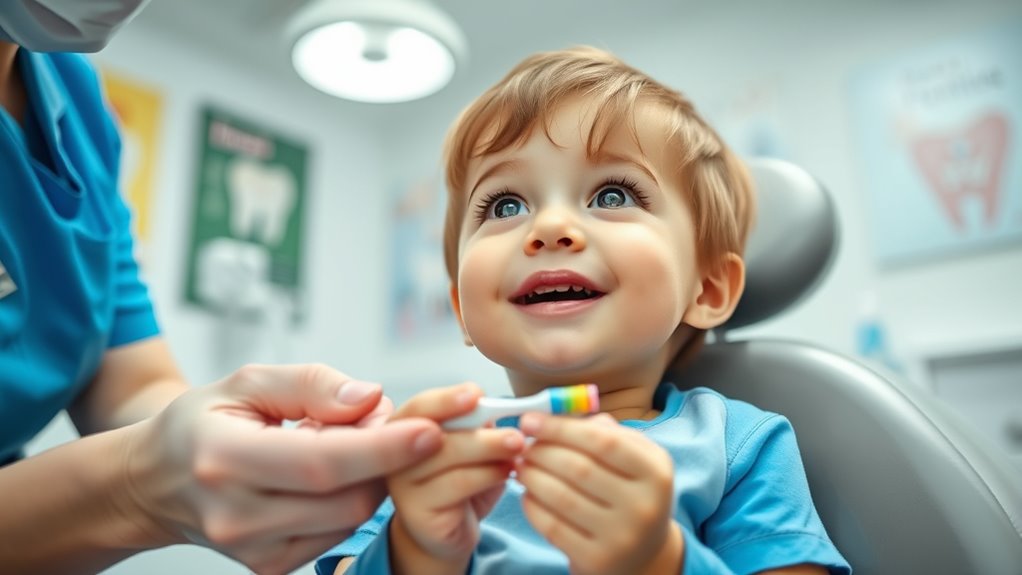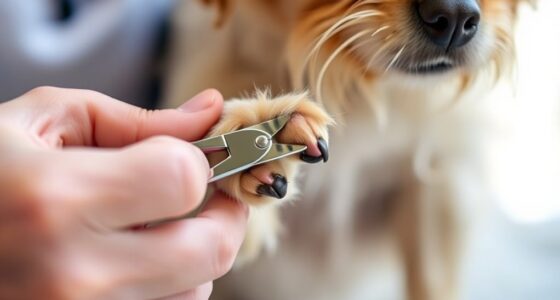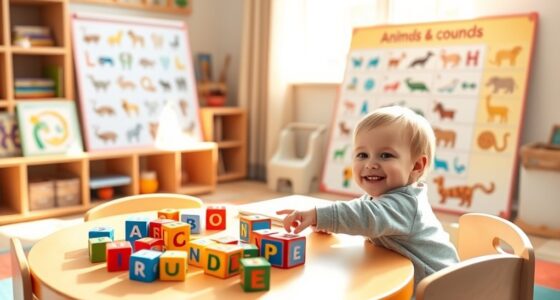To care for your toddler’s teeth, brush twice daily with a small, soft-bristled toothbrush and a pea-sized amount of fluoride toothpaste, using gentle circular motions at a 45-degree angle to gums. Guarantee fluoride intake is appropriate by supervising to prevent swallowing, and consult your dentist about fluoride supplements if needed. Schedule the first dental visit around their first birthday, creating positive experiences early. Keep learning simple tips to help your child develop healthy dental habits for life.
Key Takeaways
- Use gentle, circular brushing with a small, soft-bristled toothbrush and a pea-sized fluoride toothpaste twice daily.
- Schedule the first dental visit by age one to prevent cavities and ease dental anxiety.
- Supervise fluoride toothpaste use to prevent swallowing and ensure appropriate fluoride intake.
- Establish a consistent oral hygiene routine early to promote healthy teeth and lifelong habits.
- Support the child during dental visits with reassurance, and use play to familiarize them with dental procedures.
How to Properly Brush Your Toddler’s Teeth
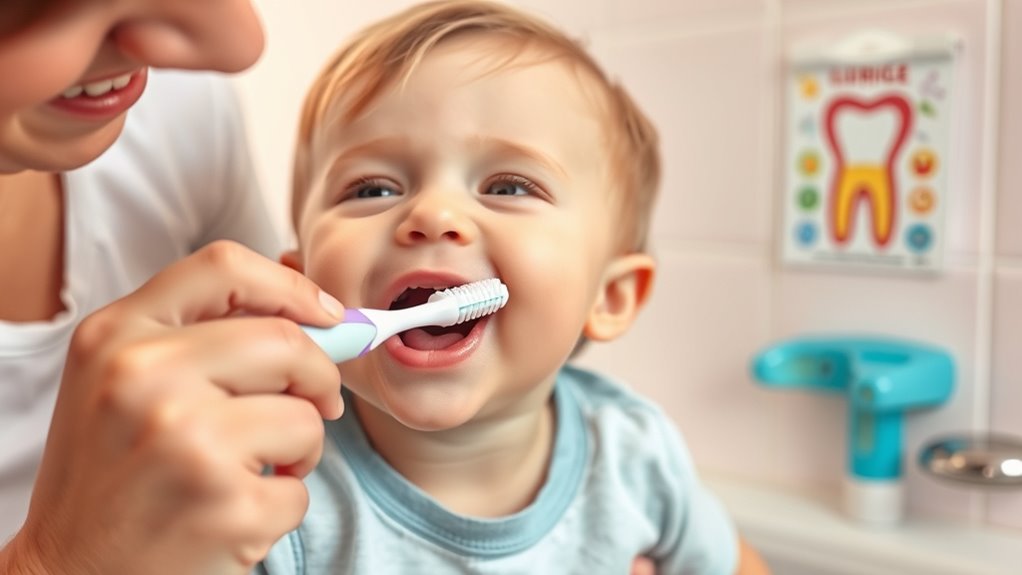
Brushing your toddler’s teeth correctly is essential for establishing good oral hygiene habits early on. Start with gentle brushing techniques, using a small, soft-bristled toothbrush suited for your child’s age. Use a pea-sized amount of toddler toothpaste, which is safe for young children. Position your child comfortably, and hold the toothbrush at a 45-degree angle to their gums. Use gentle, circular motions to clean all surfaces of each tooth, including the fronts, backs, and chewing surfaces. Be patient and keep the experience positive, praising your toddler to make brushing enjoyable. Avoid rushing or using too much pressure. Regularly replacing the toothbrush every three months or after illness helps maintain effective brushing and healthy teeth. Additionally, understanding the importance of contrast ratio can help you choose a toothbrush with the right features to ensure thorough cleaning.
The Importance of Fluoride and How to Use It Safely
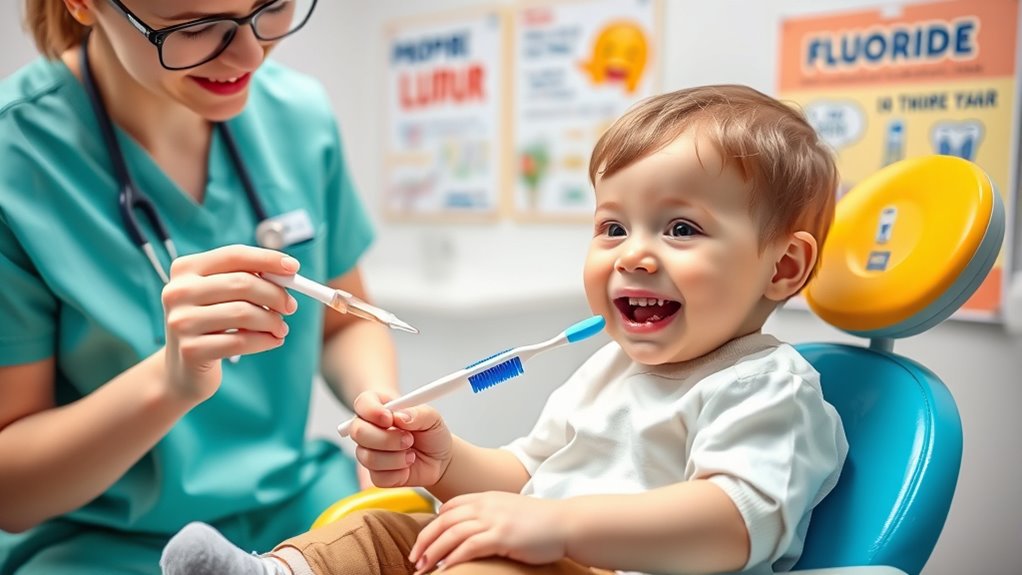
Because fluoride strengthens your toddler’s developing teeth and helps prevent cavities, it’s important to use it safely and effectively. Fluoride safety means monitoring the amount your child uses to avoid fluorosis, which can occur with excess fluoride. Typical fluoride sources include fluoridated toothpaste, community water supplies, and certain foods and drinks. To ensure safe use, apply a smear or rice-sized amount of fluoride toothpaste and supervise your child while brushing to prevent swallowing. If your water isn’t fluoridated, ask your dentist about fluoride supplements or rinses suitable for your child’s age. Remember, moderation is key—too much fluoride can be harmful, so always follow dental recommendations to protect your toddler’s teeth while maximizing the benefits of fluoride.
When and How to Introduce Your Child to Their First Dental Visit
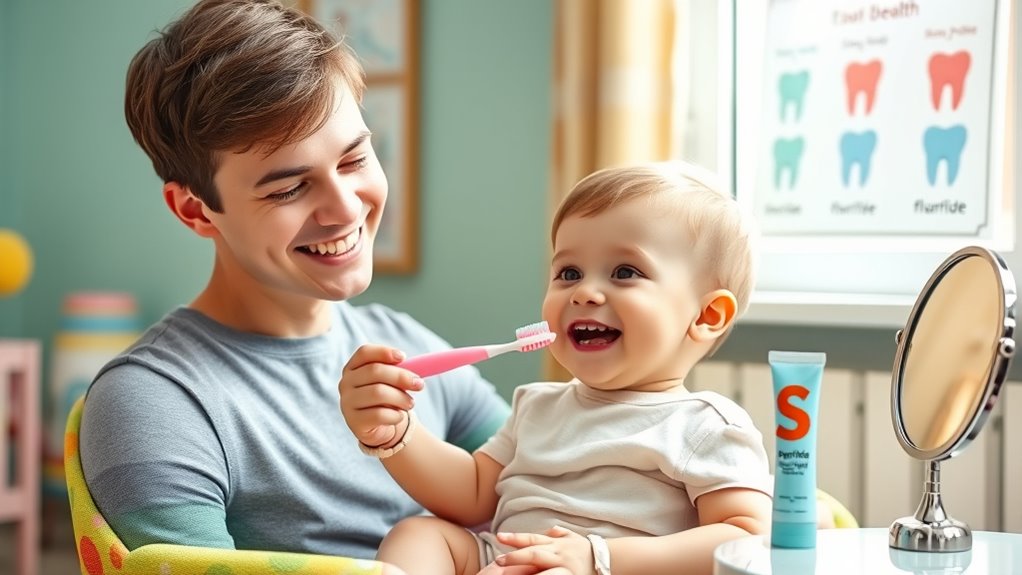
Introducing your child to their first dental visit should happen around their first birthday or when their first tooth erupts. Early visits help prevent dental anxiety and make the experience positive. Keep the appointment simple: stay calm, speak softly, and use encouraging words. Your involvement is key—stay close and hold their hand if needed. Avoid forcing your child into the chair; instead, let them explore the dentist’s office gradually. Play pretend dental checkups at home to familiarize them with the process. If you’re calm and supportive, your child will feel more secure. Remember, making the first visit a friendly, relaxed experience sets the foundation for good dental habits and reduces fear later on. Additionally, understanding the importance of early dental care can help you prepare and ensure your child’s oral health develops properly from the start. Establishing a routine dental hygiene early on encourages lifelong healthy habits and can make future visits more comfortable. Being aware of Glycolic Acid Benefits for Skin can also help you understand the importance of gentle exfoliation in skincare routines, which is crucial for maintaining healthy skin as your child grows.
Frequently Asked Questions
When Should I Start Using a Training Toothpaste for My Toddler?
You should start using a training toothpaste for your toddler around age two, or when they can spit out toothpaste effectively. Training toothpaste helps establish good toddler oral hygiene habits while being safe if swallowed in small amounts. Choose a fluoride-free or low-fluoride option designed for young children. Encourage gentle brushing twice daily, making it a fun routine that promotes healthy teeth and creates positive dental habits early on.
How Can I Make Dental Visits Less Stressful for My Child?
To ease your child’s dental anxiety, start by choosing a friendly, gentle dentist and schedule visits when your child is calm. Talk positively about dental visits, and read books or watch videos about going to the dentist to create positive dental experiences. Bring comfort items, stay relaxed, and avoid rushing. These steps help your child feel safe, making dental visits less stressful and more enjoyable.
Are There Specific Toothbrushes Recommended for Toddlers?
Think of toddler toothbrushes as tiny superheroes fighting off sugar villains. Opt for age-appropriate brushes with soft bristles that gently clean your child’s teeth without hurting their gums. Look for toddler toothbrushes designed specifically for small hands and mouths, usually with fun characters or bright colors. These tools make brushing easier and more enjoyable, ensuring your little one develops healthy habits early on.
How Do I Handle Toddler Resistance to Brushing?
You handle toddler resistance to brushing by employing behavior management techniques and positive reinforcement. Make brushing fun by singing songs or using a favorite toy as a distraction. Praise your child enthusiastically when they cooperate, and offer small rewards for brushing well. Consistency is key—establish a routine, stay patient, and gently encourage them, making the experience positive so they gradually learn to accept brushing as a normal part of their day.
What Are Signs of Dental Problems in Toddlers to Watch For?
You should watch for early cavity signs like white spots or brown stains on your toddler’s teeth, which indicate decay. Also, look for gum inflammation, such as redness or swelling, that could signal infection or irritation. If your child complains of tooth pain or avoids eating, these are signs of dental problems. Regular dental check-ups help catch issues early and keep your toddler’s smile healthy.
Conclusion
By brushing regularly, applying fluoride carefully, and visiting the dentist early, you’re setting your toddler on a path to healthy teeth. Consistency builds confidence, routines create security, and care fosters trust. When you prioritize these steps, you’re not just preventing cavities—you’re nurturing a lifetime of healthy smiles, a foundation of good habits, and a future of confidence. Remember, your gentle guidance today shapes their bright, confident smile tomorrow.
